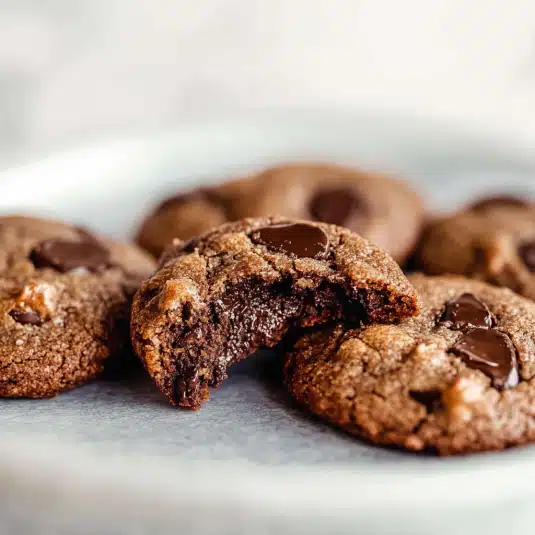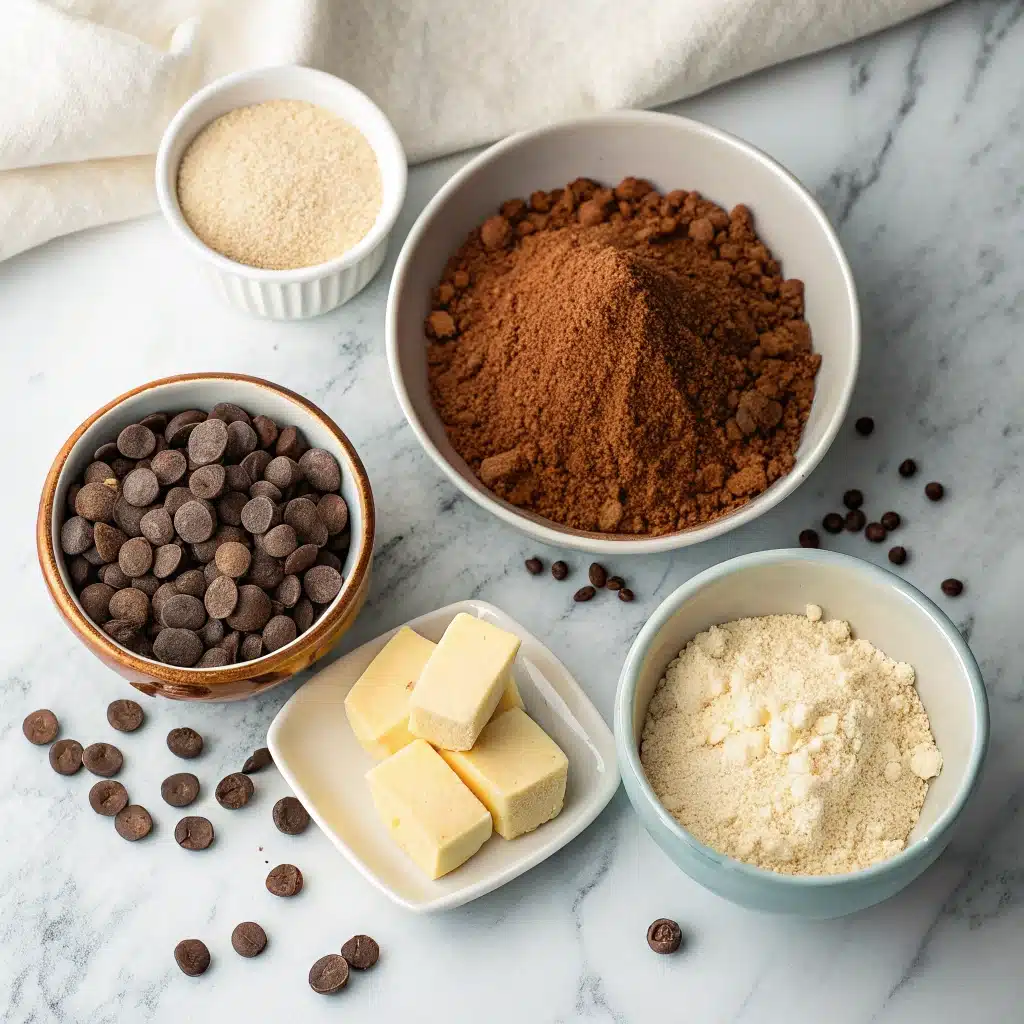Almond flour chocolate cookies are the perfect blend of rich cocoa flavor and the nutty, buttery taste of almond flour. These cookies deliver a soft, chewy center with a crisp edge, making them irresistible for chocolate lovers and health-conscious bakers alike. Gluten-free, low-carb, and naturally nutrient-rich, they’re a smarter way to indulge without sacrificing taste. In this guide, you’ll discover why almond flour is a baking game-changer, how to master the perfect cookie texture, and creative variations to keep your baking exciting.
Learn more about rich chocolate variations in our Triple Chocolate Cookies recipe for inspiration.

Table of Contents
Introduction to Almond Flour Chocolate Cookies
What Makes Almond Flour Chocolate Cookies Special
Almond flour chocolate cookies stand out because they combine intense chocolate flavor with the delicate sweetness and moist texture of almond flour. The natural fats in almond flour create a cookie that stays tender for days, while its nutty undertones enhance the richness of chocolate. This combination gives you a dessert that’s satisfying yet lighter than traditional wheat flour cookies.
The balance between cocoa’s boldness and almond flour’s subtle sweetness means you can reduce added sugar without losing flavor. If you’ve ever had gluten-free cookies turn out dry or dense, you’ll love how almond flour produces a softer, more tender bite.

Almond Flour Chocolate Cookies
- Total Time: 22 minutes
- Yield: 12 cookies 1x
Description
Almond flour chocolate cookies are the perfect blend of rich cocoa flavor and the nutty, buttery taste of almond flour. Soft in the center with crisp edges, these gluten-free, low-carb delights are made for chocolate lovers and health-conscious bakers.
Ingredients
- 2 cups blanched almond flour (finely ground)
- 1/4 cup unsweetened cocoa powder (high quality)
- 1/2 tsp baking soda
- 1/4 tsp salt
- 1 large egg (room temperature)
- 1/4 cup coconut oil or butter, melted
- 1/3 cup maple syrup or low-carb sweetener
- 1 tsp vanilla extract
- 1/2 cup chocolate chips (dark, semi-sweet, or sugar-free)
Instructions
- Preheat the oven to 350°F (175°C) and line a baking sheet with parchment paper.
- In a large bowl, whisk together almond flour, cocoa powder, baking soda, and salt.
- In another bowl, mix egg, melted coconut oil or butter, maple syrup (or sweetener), and vanilla extract.
- Combine wet and dry ingredients until just mixed. Do not overmix.
- Fold in chocolate chips.
- Scoop dough onto the prepared baking sheet, spacing about 2 inches apart.
- Bake for 10–12 minutes, until edges are set but centers remain soft.
- Cool on the pan for 5 minutes, then transfer to a wire rack to cool completely.
Notes
Chill dough for 30 minutes before baking for chewier cookies. Use finely ground blanched almond flour to avoid gritty texture. Store in an airtight container for up to 4 days or freeze for longer freshness.
- Prep Time: 10 minutes
- Cook Time: 12 minutes
- Category: Dessert
- Method: Baking
- Cuisine: American
Nutrition
- Serving Size: 1 cookie
- Calories: 160
- Sugar: 4g
- Sodium: 90mg
- Fat: 13g
- Saturated Fat: 5g
- Unsaturated Fat: 7g
- Trans Fat: 0g
- Carbohydrates: 7g
- Fiber: 2g
- Protein: 4g
- Cholesterol: 15mg
Why Almond Flour Is a Game-Changer for Baking
Almond flour isn’t just a substitute—it’s an upgrade. Made from finely ground blanched almonds, it’s packed with protein, fiber, and healthy fats that create a moist, rich crumb in baked goods. It blends smoothly into dough, making it ideal for cookies, cakes, and brownies.
Because it’s gluten-free, almond flour needs the help of eggs or other binders to provide structure. The result? Cookies with a melt-in-your-mouth texture that’s perfect for anyone following keto, paleo, or gluten-free diets.
Benefits of Using Almond Flour in Cookies

Nutritional Advantages of Almond Flour
One of the biggest reasons to choose almond flour chocolate cookies over traditional cookies is the nutritional boost. Almond flour, made from finely ground almonds, is naturally gluten-free and packed with protein, healthy fats, and vitamin E. These nutrients not only support heart health but also help keep you fuller for longer, making your sweet treat a bit more satisfying.
Compared to wheat flour, almond flour has a lower glycemic index, which means it won’t spike your blood sugar as much. This is why gluten-free chocolate cookies made with almond flour are popular among people on low-carb, keto, and diabetic-friendly diets. The combination of healthy fats and fiber helps stabilize energy levels while still delivering indulgent flavor.
Gluten-Free, Low-Carb, and Keto-Friendly Benefits
If you’re following a specific diet plan, almond flour chocolate cookies can fit right in. Almond flour is naturally low in carbs and completely grain-free, making it perfect for keto and paleo lifestyles. You can pair it with sugar alternatives like monk fruit, stevia, or erythritol to create cookies that are both low in sugar and big on taste.
Another advantage is its versatility—almond flour pairs well with dark chocolate, milk chocolate, or even sugar-free chips without losing its signature chewy texture. This makes it easy to experiment with different flavors while keeping your recipe healthy.
Key Ingredients for Almond Flour Chocolate Cookies

Choosing the Right Almond Flour
The quality of your almond flour makes all the difference in almond flour chocolate cookies. Look for finely ground, blanched almond flour for the smoothest texture. Blanched means the skins have been removed before grinding, which prevents bitterness and helps your cookies bake evenly. If you use almond meal (made from unblanched almonds), your cookies may have a slightly grittier texture and darker color.
When possible, choose a fresh, well-sealed package to avoid rancid flavors, since almond flour’s natural oils can spoil if stored improperly. For optimal freshness, store almond flour in the refrigerator or freezer to prolong its shelf life.
Best Chocolate Types for Perfect Flavor
Chocolate is the heart of grain-free chocolate cookies, so it’s worth choosing high-quality options. Dark chocolate with at least 60% cacao adds richness and balances the natural sweetness of almond flour. For a sweeter flavor, use semi-sweet or milk chocolate chips.
If you want to make healthy chocolate cookie recipes, try sugar-free chocolate chips or bars sweetened with stevia or monk fruit. You can also try using chopped chocolate chunks for rich pockets of melted chocolate in every bite. Whatever you choose, make sure it’s stable during baking so your cookies hold their shape while still having a gooey center.
Step-by-Step Recipe for Almond Flour Chocolate Cookies
Ingredient Measurements and Preparation Tips
Making almond flour chocolate cookies is easy when you start with the right ingredients and accurate measurements. Here’s what you’ll need for about 12 medium-sized almond flour chocolate cookies:
| Ingredient | Measurement | Notes |
|---|---|---|
| Blanched almond flour | 2 cups | Finely ground for smooth texture in almond flour chocolate cookies |
| Cocoa powder | 1/4 cup | Unsweetened, high quality for rich chocolate taste |
| Baking soda | 1/2 tsp | Helps the cookies rise slightly |
| Salt | 1/4 tsp | Balances sweetness |
| Egg | 1 large | Room temperature for best mixing |
| Coconut oil or butter | 1/4 cup, melted | Adds moisture and richness |
| Maple syrup or low-carb sweetener | 1/3 cup | Adjust to taste for your cookies |
| Vanilla extract | 1 tsp | Deepens flavor |
| Chocolate chips | 1/2 cup | Dark, semi-sweet, or sugar-free options work well |
Prep Tip: For the smoothest texture, whisk almond flour, cocoa powder, and other dry ingredients together before adding wet ones. If using coconut oil, make sure it’s fully melted but not hot, so it blends well without cooking the egg.
Baking Method and Timing for Chewy Texture
- Preheat the oven to 350°F (175°C) and line a baking sheet with parchment paper.
- Mix dry ingredients—almond flour, cocoa powder, baking soda, and salt—in a large bowl.
- Combine wet ingredients—egg, melted coconut oil or butter, sweetener, and vanilla—in another bowl.
- Fold wet into dry gently until just combined. Overmixing can make almond flour chocolate cookies dense.
- Add chocolate chips and stir until evenly distributed.
- Scoop cookie dough onto the baking sheet, spacing each one about 2 inches apart.
- Bake for 10–12 minutes, until the edges are set but the centers remain soft.
- Let cool on the pan for 5 minutes before moving to a wire rack.
Pro Tip: Chilling your dough for 30 minutes before baking can make almond flour chocolate cookies chewier and help them hold their shape better.
Check out our tips for buttery texture in Chocolate Shortbread Cookies for more baking inspiration.
Tips for Perfect Almond Flour Cookie Texture
How to Avoid Grittiness in Almond Flour Cookies
One common complaint with almond flour chocolate cookies is a slightly gritty texture. This usually happens when the almond flour isn’t finely ground enough or if almond meal (with skins) is used instead of blanched almond flour. Always choose finely milled, blanched almond flour for the smoothest bite.
Another trick is to let your cookie dough rest for 10–15 minutes before baking. This allows the almond flour to absorb moisture from the wet ingredients, softening the grain and resulting in a smoother texture once baked.
Moisture Balance and Fat Content Secrets
Getting the perfect texture in almond flour chocolate cookies is all about balancing moisture and fat. Almond flour has a higher fat content than wheat flour, so using too much added oil or butter can cause cookies to spread too much or turn greasy.
Instead, measure fats carefully and consider adding a tablespoon of coconut flour if your dough feels too wet. Coconut flour absorbs extra moisture without altering the flavor.
If you like your cookies extra chewy, slightly underbake them and let them finish setting on the hot baking sheet. This technique helps lock in moisture and gives you that soft, decadent center that makes almond flour chocolate cookies irresistible.
Flavor Variations and Add-Ins
Nutty, Fruity, and Spiced Additions
While classic almond flour chocolate cookies are hard to beat, adding mix-ins can take them to the next level. For added crunch, mix in chopped walnuts, pecans, or hazelnuts. Dried fruits like cranberries, cherries, or apricots add a chewy, tart contrast to the rich chocolate flavor.
Spices can also transform the taste. A pinch of cinnamon or a dash of espresso powder can deepen the chocolate’s richness, while cardamom or nutmeg brings a warm, aromatic twist.
Looking for festive flavors? Try our Cranberry Pistachio Shortbread Cookies for a holiday-inspired take you can adapt to almond flour chocolate cookies.
Sugar-Free and Dairy-Free Adaptations
If you’re aiming for healthy chocolate cookie recipes, it’s easy to adapt almond flour chocolate cookies for different dietary needs. Replace regular chocolate chips with sugar-free or stevia-sweetened versions to keep carbs low. For a dairy-free option, replace butter with coconut oil or vegan butter alternatives.
You can even experiment with flavored extracts—peppermint for a holiday treat, orange for a citrusy lift, or almond extract for a double almond flavor. These small tweaks let you customize your almond flour chocolate cookies without sacrificing their chewy, indulgent texture.
Storing and Freezing Almond Flour Chocolate Cookies
Short-Term Storage for Freshness
Freshly baked almond flour chocolate cookies taste best within the first couple of days, but you can easily keep them fresh for longer with proper storage. Place completely cooled cookies in an airtight container and store them at room temperature for up to 4 days. To prevent them from sticking together, layer them with parchment paper.
If you prefer a softer texture, store your cookies with a slice of bread in the container—the bread will release moisture, keeping your almond flour chocolate cookies tender and chewy.
Long-Term Freezing and Thawing Tips
Almond flour chocolate cookies also freeze beautifully. Arrange cooled cookies in a single layer on a baking sheet, freeze until firm, then transfer them to a freezer-safe bag or container. This prevents them from sticking together.
You can store them frozen for up to 3 months without losing flavor or texture. To enjoy, thaw at room temperature for 20–30 minutes or warm them in the oven at 300°F (150°C) for a few minutes to restore their freshly baked softness.
If you want fresh cookies any time, freeze unbaked dough balls instead. That way, you can bake just the right amount of almond flour chocolate cookies on demand.
Common Baking Mistakes and How to Fix Them
Overbaking and Undermixing Issues
One of the most common mistakes when making almond flour chocolate cookies is overbaking. Because almond flour doesn’t brown as much as wheat flour, it can be tricky to judge doneness. Bake until the edges are set, even if the centers appear slightly soft—they will firm up as they cool.
Undermixing, on the other hand, can leave pockets of dry almond flour or uneven distribution of chocolate chips. Always mix until the dough is cohesive, but avoid overmixing, which can make the cookies dense.
Check out our chewy Honey Cookies for soft-bake inspiration and a unique way to balance moisture.
Adjusting Sweetness and Texture
If your almond flour chocolate cookies turn out too sweet, try reducing the sugar slightly or using darker chocolate chips. For a less sweet but still indulgent flavor, add a sprinkle of flaky sea salt on top before baking.
When cookies spread too much, it’s often due to excess fat or insufficient chilling of the dough. Chilling for at least 30 minutes before baking helps the cookies keep their shape. If your cookies are too dry, add a tablespoon of almond milk or an extra egg yolk to the dough for more moisture and chewiness.
FAQs
What is the secret to baking with almond flour?
The secret to baking with almond flour is choosing finely ground, blanched almond flour and measuring it correctly. Because almond flour is high in fat, it behaves differently from wheat flour—it needs the right balance of wet and dry ingredients to achieve the perfect texture. In almond flour chocolate cookies, chilling the dough before baking helps them hold their shape and enhances flavor.
Are almond flour chocolate chip cookies good?
Yes! Almond flour chocolate cookies are delicious and have a rich, nutty flavor that pairs perfectly with chocolate. The texture is soft and chewy, with a slight crisp on the outside. They’re also naturally gluten-free, which makes them a great option for those avoiding wheat.
Does almond flour make cookies gritty?
It can, but only if you use coarse almond meal or skip the resting step. For smooth almond flour chocolate cookies, always choose finely milled, blanched almond flour and let your dough rest for 10–15 minutes before baking to allow the flour to fully hydrate.
How does almond flour affect cakes?
Almond flour adds moisture and density to cakes, giving them a tender crumb and slightly nutty flavor. While this works beautifully in almond flour chocolate cookies, in cakes it can make the texture a bit heavier than wheat flour. To lighten cakes, you can mix almond flour with a gluten-free blend.
Discover more cookie textures in our Condensed Milk Cookies recipe for comparison and inspiration.
Conclusion
Almond flour chocolate cookies are proof that you can have a decadent, chocolatey treat without compromising on nutrition or flavor. Whether you’re baking for a gluten-free diet, following keto guidelines, or simply looking for a rich and chewy cookie, almond flour delivers both taste and texture.
From understanding the benefits of almond flour to perfecting the baking process, you now have all the tools to make these cookies turn out bakery-quality every time. Don’t be afraid to experiment with flavors, add-ins, and even sugar-free adaptations to make the recipe your own.
If you’re ready to elevate your dessert game, these almond flour chocolate cookies are a delicious place to start—bringing together wholesome ingredients and indulgent flavor in every bite.
Learn more about other rich cookie creations in our Cream Cheese Chocolate Chip Cookies for another chewy favorite.
Fore more recipes follow me in Facebook, medium and Pinterest




